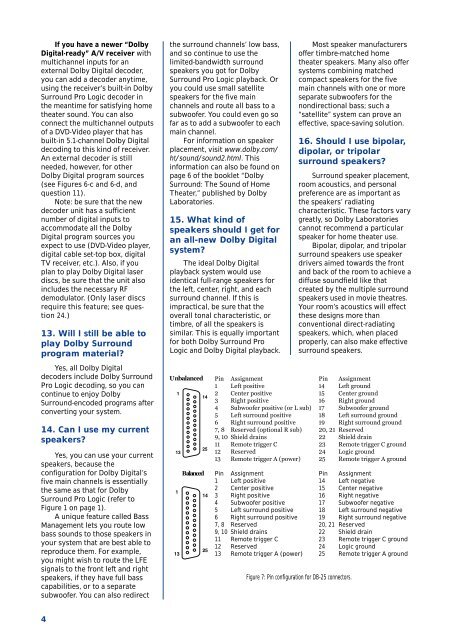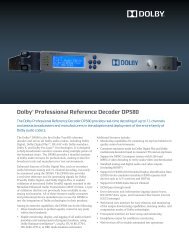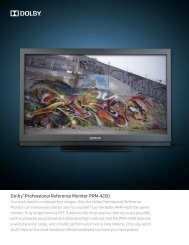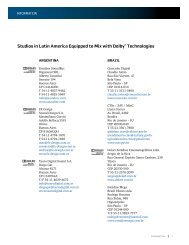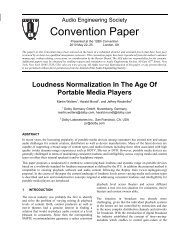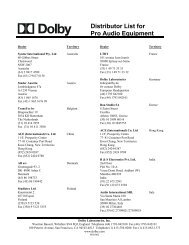Frequently asked QUESTIONS about DOLBY DIGITAL
Frequently asked QUESTIONS about DOLBY DIGITAL
Frequently asked QUESTIONS about DOLBY DIGITAL
Create successful ePaper yourself
Turn your PDF publications into a flip-book with our unique Google optimized e-Paper software.
If you have a newer “Dolby<br />
Digital-ready” A/V receiver with<br />
multichannel inputs for an<br />
external Dolby Digital decoder,<br />
you can add a decoder anytime,<br />
using the receiver’s built-in Dolby<br />
Surround Pro Logic decoder in<br />
the meantime for satisfying home<br />
theater sound. You can also<br />
connect the multichannel outputs<br />
of a DVD-Video player that has<br />
built-in 5.1-channel Dolby Digital<br />
decoding to this kind of receiver.<br />
An external decoder is still<br />
needed, however, for other<br />
Dolby Digital program sources<br />
(see Figures 6-c and 6-d, and<br />
question 11).<br />
Note: be sure that the new<br />
decoder unit has a sufficient<br />
number of digital inputs to<br />
accommodate all the Dolby<br />
Digital program sources you<br />
expect to use (DVD-Video player,<br />
digital cable set-top box, digital<br />
TV receiver, etc.). Also, if you<br />
plan to play Dolby Digital laser<br />
discs, be sure that the unit also<br />
includes the necessary RF<br />
demodulator. (Only laser discs<br />
require this feature; see question<br />
24.)<br />
13. Will I still be able to<br />
play Dolby Surround<br />
program material?<br />
Yes, all Dolby Digital<br />
decoders include Dolby Surround<br />
Pro Logic decoding, so you can<br />
continue to enjoy Dolby<br />
Surround-encoded programs after<br />
converting your system.<br />
14. Can I use my current<br />
speakers?<br />
Yes, you can use your current<br />
speakers, because the<br />
configuration for Dolby Digital’s<br />
five main channels is essentially<br />
the same as that for Dolby<br />
Surround Pro Logic (refer to<br />
Figure 1 on page 1).<br />
A unique feature called Bass<br />
Management lets you route low<br />
bass sounds to those speakers in<br />
your system that are best able to<br />
reproduce them. For example,<br />
you might wish to route the LFE<br />
signals to the front left and right<br />
speakers, if they have full bass<br />
capabilities, or to a separate<br />
subwoofer. You can also redirect<br />
4<br />
the surround channels’ low bass,<br />
and so continue to use the<br />
limited-bandwidth surround<br />
speakers you got for Dolby<br />
Surround Pro Logic playback. Or<br />
you could use small satellite<br />
speakers for the five main<br />
channels and route all bass to a<br />
subwoofer. You could even go so<br />
far as to add a subwoofer to each<br />
main channel.<br />
For information on speaker<br />
placement, visit www.dolby.com/<br />
ht/sound/sound2.html. This<br />
information can also be found on<br />
page 6 of the booklet “Dolby<br />
Surround: The Sound of Home<br />
Theater,” published by Dolby<br />
Laboratories.<br />
15. What kind of<br />
speakers should I get for<br />
an all-new Dolby Digital<br />
system?<br />
The ideal Dolby Digital<br />
playback system would use<br />
identical full-range speakers for<br />
the left, center, right, and each<br />
surround channel. If this is<br />
impractical, be sure that the<br />
overall tonal characteristic, or<br />
timbre, of all the speakers is<br />
similar. This is equally important<br />
for both Dolby Surround Pro<br />
Logic and Dolby Digital playback.<br />
Unbalanced<br />
Balanced<br />
Most speaker manufacturers<br />
offer timbre-matched home<br />
theater speakers. Many also offer<br />
systems combining matched<br />
compact speakers for the five<br />
main channels with one or more<br />
separate subwoofers for the<br />
nondirectional bass; such a<br />
“satellite” system can prove an<br />
effective, space-saving solution.<br />
16. Should I use bipolar,<br />
dipolar, or tripolar<br />
surround speakers?<br />
Surround speaker placement,<br />
room acoustics, and personal<br />
preference are as important as<br />
the speakers’ radiating<br />
characteristic. These factors vary<br />
greatly, so Dolby Laboratories<br />
cannot recommend a particular<br />
speaker for home theater use.<br />
Bipolar, dipolar, and tripolar<br />
surround speakers use speaker<br />
drivers aimed towards the front<br />
and back of the room to achieve a<br />
diffuse soundfield like that<br />
created by the multiple surround<br />
speakers used in movie theatres.<br />
Your room’s acoustics will effect<br />
these designs more than<br />
conventional direct-radiating<br />
speakers, which, when placed<br />
properly, can also make effective<br />
surround speakers.<br />
Pin Assignment Pin Assignment<br />
1 Left positive 14 Left ground<br />
2 Center positive 15 Center ground<br />
3 Right positive 16 Right ground<br />
4 Subwoofer positive (or L sub)17 Subwoofer ground<br />
5 Left surround positive 18 Left surround ground<br />
6 Right surround positive 19 Right surround ground<br />
7, 8 Reserved (optional R sub)20, 21 Reserved<br />
9, 10 Shield drains 22 Shield drain<br />
11 Remote trigger C 23 Remote trigger C ground<br />
12 Reserved 24 Logic ground<br />
13 Remote trigger A (power)25 Remote trigger A ground<br />
Pin Assignment Pin Assignment<br />
1 Left positive 14 Left negative<br />
2 Center positive 15 Center negative<br />
3 Right positive 16 Right negative<br />
4 Subwoofer positive 17 Subwoofer negative<br />
5 Left surround positive 18 Left surround negative<br />
6 Right surround positive 19 Right surround negative<br />
7, 8 Reserved 20, 21 Reserved<br />
9, 10 Shield drains 22 Shield drain<br />
11 Remote trigger C 23 Remote trigger C ground<br />
12 Reserved 24 Logic ground<br />
13 Remote trigger A (power) 25 Remote trigger A ground<br />
Figure 7: Pin configuration for DB-25 connectors.


